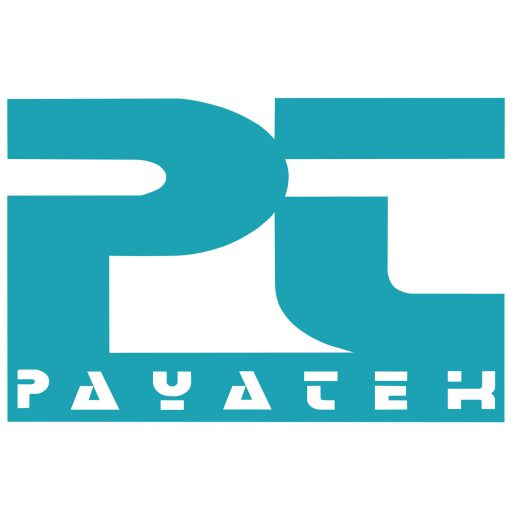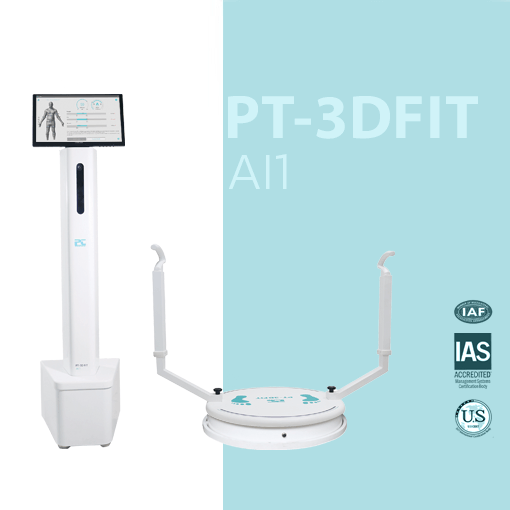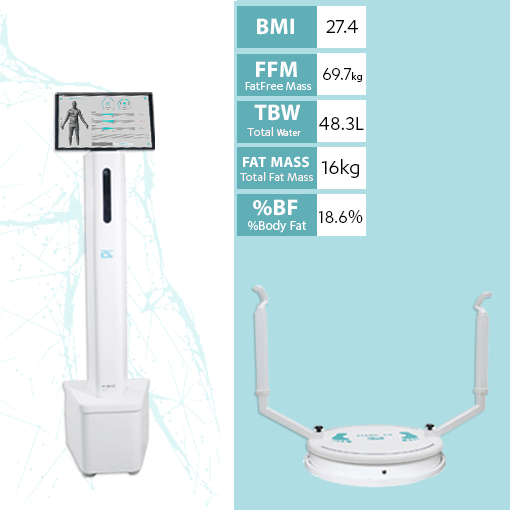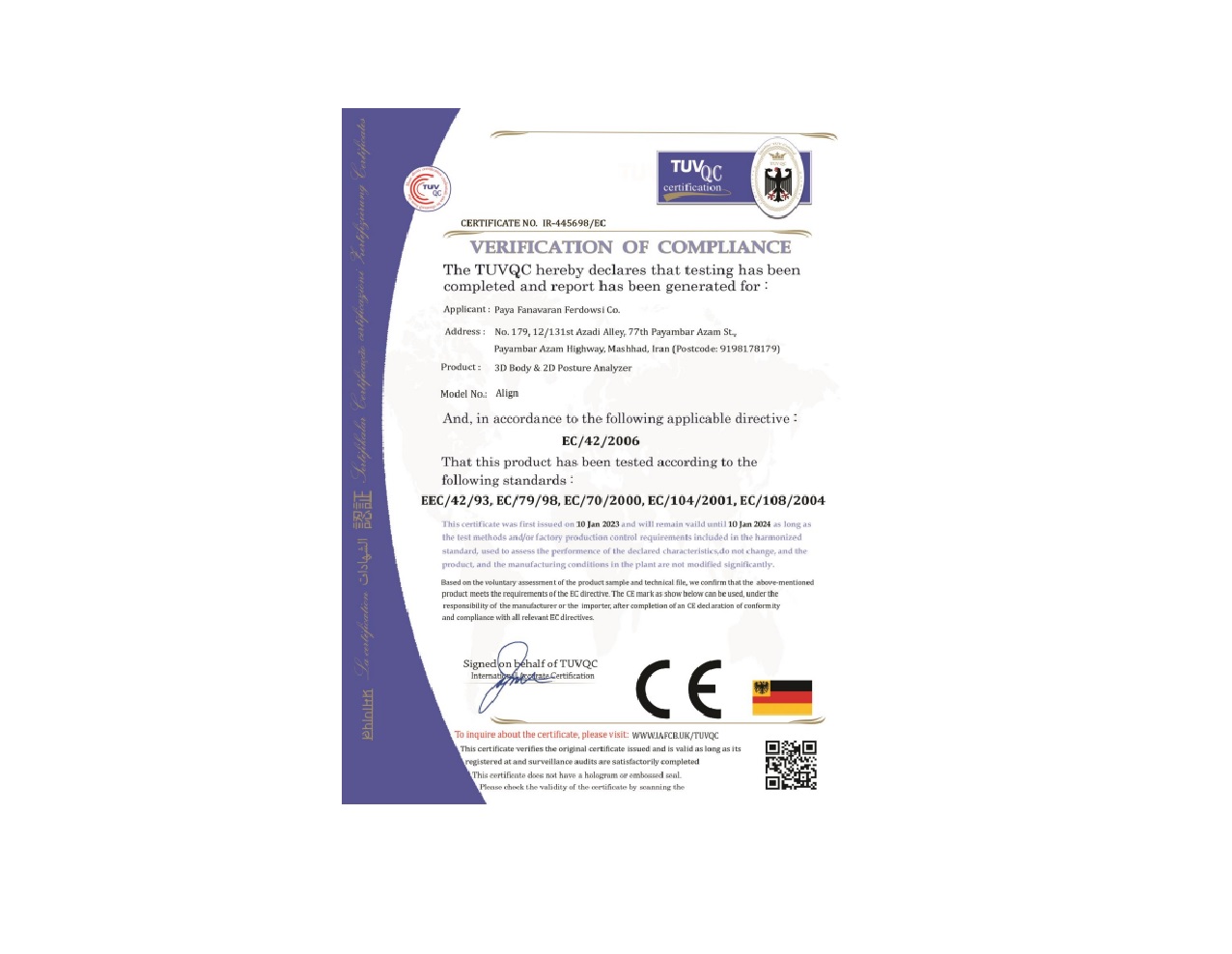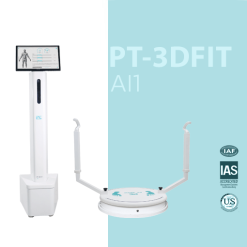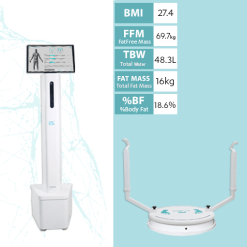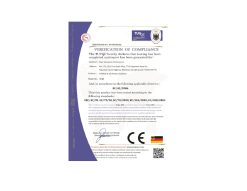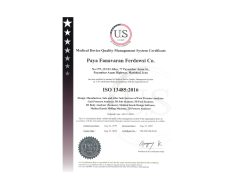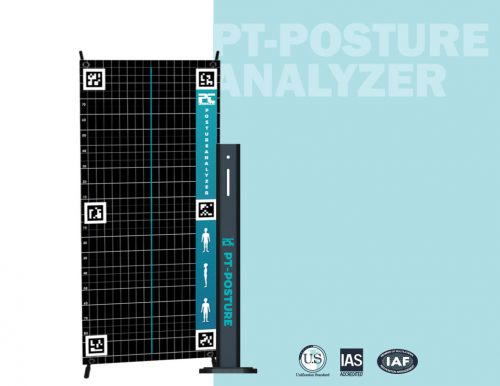The PayaTek 3D Body Scanner (PT_3DFit) is a state-of-the-art 3D body scanner designed to precisely track body size changes and overall health during workout and diet programs. It uses non-invasive 3D scanning technology to provide a detailed analysis of the external body surfaces, capturing key anthropometric data such as volume, surface area, length, circumference, and width.
This powerful device also evaluates body composition, including the percentages of water, muscle, and fat, offering an accurate and detailed 3D model of the body. The PT 3Dfit acts as a 3D mirror, allowing specialists to effortlessly monitor their clients’ progress and make informed decisions about their health and fitness journey.
 It utilizes Time-of-Flight technology, which measures depth using light signals—a completely safe and risk-free method suitable for all users in any condition.
It utilizes Time-of-Flight technology, which measures depth using light signals—a completely safe and risk-free method suitable for all users in any condition.
What is a 3D Body Scanner?
A 3D body scanner is an advanced technology that enables precise modeling of body dimensions and muscle volume using laser and optical scanning systems. We provide unparalleled insights into body composition by integrating 3D body scanning technology into the fitness and health industry. This helps specialists and coaches better understand their clients’ physical fitness and make informed decisions to enhance overall health.
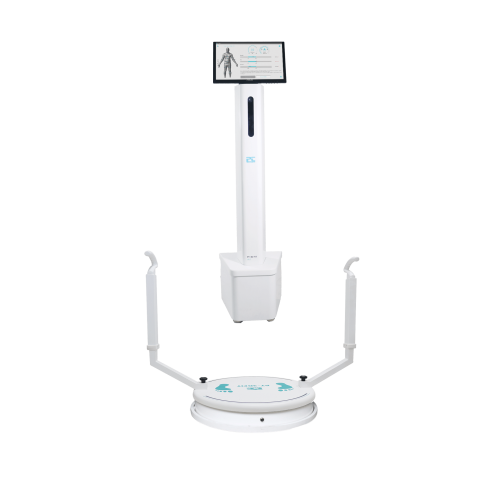
Features of Payatek’s 3D body scanner, PT-3D Fit, include:
- high accuracy in body size measurement
- providing body health indicators such as metabolic age, BMR, TLR, and …
- fast scan, less than 40 seconds
Among the features that make Payatek’s 3D body scanner accurate and reliable are:
- Very high reliability in body composition analysis
- More than 92% correlation of body composition calculation with DEXA gold standard
- Easy to move and reinstall
- More than 30 practical factors for specialists to consider when evaluating device output
- Fast scan, takes less than 40 seconds
- Global standards
Losing Weight or Dieting with the Help of a 3D Body Scanner
There is no need for inaccurate manual measurements with this 3D body scanner. The device provides body dimensions and sizes quickly and with high accuracy. Beyond basic measurements, it provides specialists with essential health metrics that cannot be measured manually. These metrics are crucial for designing personalized diet and exercise plans, including:
✔ Body fat percentage
✔ Water composition
✔ Metabolic rate (BMR)
✔ Bone size
Other key indicators essential for designing personalized diet and fitness plans
The PT-3DFit scanner generates comprehensive reports by comparing current body data with previous test results. This feature allows individuals to visualize their transformation over time, making progress tangible and boosting motivation to stay on track with their weight loss or fitness journey.
How Does the 3D Body Scanner Provide Health Parameters to the User?
The 3D body scanner determines health parameters by analyzing various biometric factors such as height, age, weight, gender, and body dimensions. The main part of the analysis is obtained by using the density calculation formula and the mass-to-volume ratio, allowing for a highly accurate assessment of body composition.
Given that different substances have different volumetric masses; for example, the volumes of one kilogram of muscle and one kilogram of fat are different from each other. After years of scientific research, validation with academic formulas, and testing against global standards, the PayaTek 3D scanner software has been refined to achieve over 96% accuracy. Through AI optimization, it now offers one of the highest correlations with DEXA scans, making it one of the most reliable body composition analysis tools available.
What is the Difference Between a 3D Body Scanner and a Body Composition Device?
BIA-based devices have limitations in providing information on body size and dimensions and are unable to extract anthropometric information. Furthermore, factors such as the examiner’s physical condition, hydration status, and presence of foreign objects in the body can significantly affect the device output.
Additionally, BIA devices are not suitable for pregnant women or individuals with implanted medical devices, as the technology relies on electrical impedance, which may interfere with medical implants or produce inaccurate readings. In contrast, a 3D body scanner provides a scientifically validated and highly reliable method for measuring body fat percentage, body dimensions, and composition. Unlike BIA devices, which rely on electrical signals, a 3D body scanner captures precise body measurements through high-resolution optical scanning and AI-driven calculations. This ensures consistent and accurate results, regardless of hydration levels or external conditions.
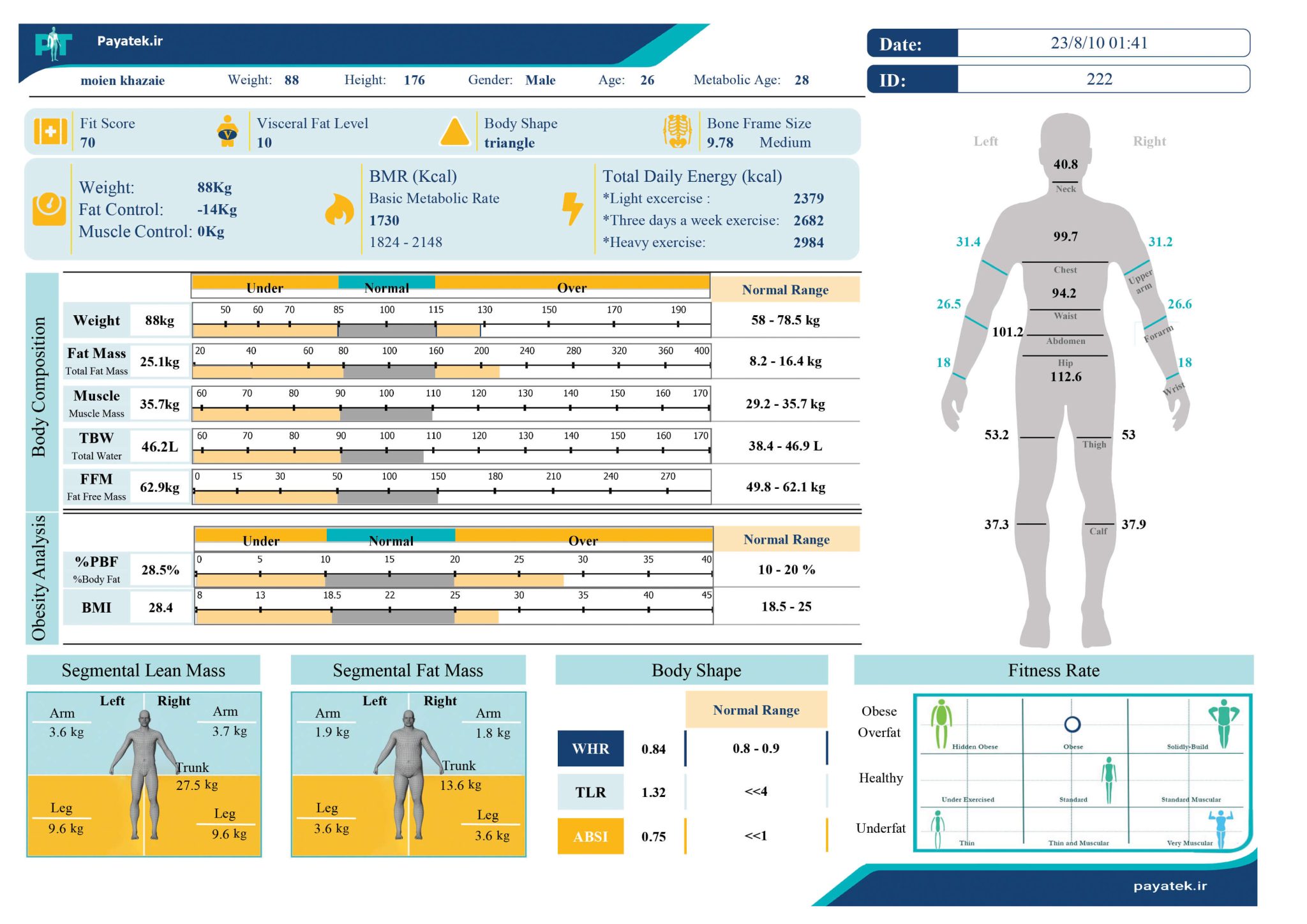
The items that are provided to the user in the output of PayaTek PT-3D Fit 3D body scanner are:
- Body Fat Mass
- Body Muscle Mass
- Body Fat Percentage (BFP)
- Fat Free Mass (FFM)
- Body Mass Index (BMI)
- Basal Metabolic Rate (BMR
- Visceral Fat
- Waist to Hip Ratio (WHR)
- Total Body Water
- Basal metabolism
- A Body Shape Index (ABSI)
- Trunk to Leg Volume Ratio (TLR)
- Metabolic Age
- Fat control
- Muscle control
- Total daily energy
- Body size balance
- Waist-to-Hip cross-section and comparison with the previous test
- Comparison of the body environment with the previous test
- Body composition comparison graphs with the previous test
- Providing a 3D view of the body
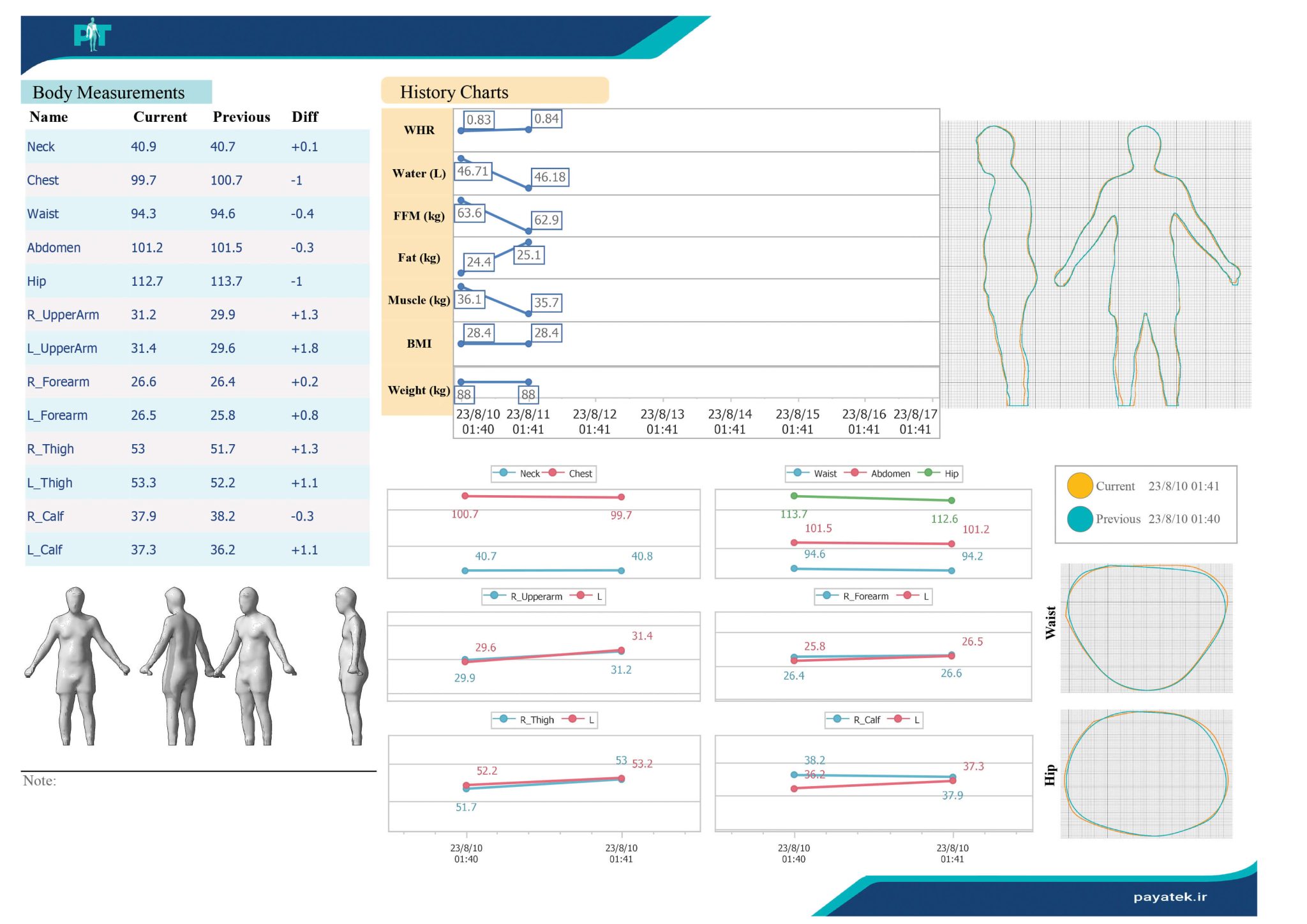
The Report of PT 3DFit | 3D Body Analyzer
The PT-3DFit 3D Body Analyzer provides a detailed, data-driven assessment of body composition and health indicators. By analyzing key biometric parameters, it helps users understand their physical health, track body composition changes, and assess potential health risks.
Key Health Metrics Analyzed by PT-3DFit:
Visceral Fat
The PayaTek 3D Body Scanner calculates visceral fat, a critical factor linked to serious health risks such as:
- Gastrointestinal cancers
- Cardiovascular disease, heart attack, and stroke
- Type 2 diabetes
- Fatty liver disease
Trunk-to-Leg Ratio (TLR)
- This ratio helps assess risk factors for diabetes and fatty liver disease.
- Determining body shape and type is essential for understanding these risks.
Body Shape Index (ABSI)
- A novel, comprehensive indicator for evaluating obesity-related risks.
- An ABSI score above 1 significantly increases the risk of mortality from obesity-related diseases.
Body Mass Index (BMI)
- BMI is a standard measurement that uses height and weight to assess whether a person’s weight falls within a healthy range.
BMI Classification:
- 5 – 24.9 → Healthy range
- 0+ → Overweight
- Below 18.5 → Underweight
Applicable to most adults aged 18-65 years.
Total Body Water (TBW)
Water is essential for survival and plays a key role in:
- Joint, bone, and organ health
- Body temperature regulation
- Nutrient delivery to cells
Waist-to-Hip Ratio (WHR)
- Provides a quick evaluation of fat distribution.
- Higher abdominal fat levels are associated with increased health risks.
Fat-Free Mass (FFM)
- Best predictor of energy expenditure in humans.
- Directly linked to resting metabolic rate and total energy expenditure under sedentary conditions.
Body Fat Mass
Essential fat levels differ for men and women:
Men:
2-5% → Essential fat
2-24% → Healthy range
25%+ → Obese
Women:
10-13% → Essential fat
10-31% → Healthy range
32%+ → Obese
Muscle Mass
- Refers to the total skeletal muscle weight of the body.
- The optimal amount of muscle mass varies based on individual goals and activity levels.
Children’s 3D Body Scan: Tracking Growth & Development
Monitoring child development is essential, as growth disorders can lead to long-term effects such as malnutrition, obesity, lack of concentration, and other physical and mental health issues in adulthood.
Why Monitor Child Development?
Experts typically evaluate children’s growth patterns by tracking them with growth charts from an early age. The PT-3D Body Scanner provides a modern, precise method for monitoring and analyzing a child’s growth over time.
Key Benefits of PT-3D Body Scanner for Children:
1- 3D Model & Volume Tracking
- The scanner generates a high-precision 3D model of the child’s body.
- Enables tracking of volume changes over time.
2- Comparative Growth Chart Analysis
The device compares a child’s growth metrics to age- and sex-specific growth charts from:
- World Health Organization (WHO)
- Centers for Disease Control and Prevention (CDC)
3- Growth Pattern Analysis & Tracking
During routine screenings, healthcare providers use the PT-3D Body Scanner for accurate growth pattern tracking. While a single growth chart measurement can help identify nutritional risks, it may not be sufficient to determine long-term growth patterns. The PT-3D Body Scanner generates detailed reports, enabling professionals to detect potential health or nutritional concerns early.
The PT-3D Body Scanner integrates 3D scanning technology to ensure precise and comprehensive growth monitoring, making it a valuable tool for healthcare providers, parents, and researchers in child development.

How to use PayaTek 3D Body Scanner?
- Wear tight-fitting clothes that allow your body to be scanned accurately
- Take off your shoes before stepping onto the platform
- Hold the handles provided on the device to start the scan
- Look straight ahead and remain still throughout the scanning process, which lasts about 40 seconds.
Your body’s comprehensive report is ready after about 1 minute. You can review and analyze the report to gain insights into your body’s composition, health risks, and other important factors. This information can be used to develop personalized diet and exercise plans that suit your individual needs and goals.
What is the difference between the PT-3D Fit and other available devices?
Enhanced User Experience & Comprehensive Reporting
The PT-3D Fit features a user-friendly and intuitive interface, making it easy for users to understand and interpret their results. It also provides comprehensive reporting tools, allowing users to track progress over time and make informed decisions about their health and fitness goals.
Portability & Versatility for Multiple Industries
Designed for convenience, the PT-3D Fit is portable, making it an ideal solution for:
✔ Gyms & fitness centers
✔ Medical clinics & healthcare providers
✔ Wellness centers & research facilities
Do You Run the 3D Body Scanner Test with or Without Clothes?
It is advisable to wear tight-fitting clothing during the 3D scanner test for optimal results, as loose clothing can distort the accuracy of the scan by creating folds or shadows that may obscure parts of the body. However, it’s important to note that the scanner does not penetrate clothing—it only captures external body surfaces. Therefore, wearing clothing during the scan will not significantly impact accuracy, as long as it fits snugly to the body. Ultimately, the choice of clothing is based on personal comfort and preference.
Key Considerations:
✔ Tight-fitting clothing is ideal to ensure precise measurements.
✔ Loose clothing may create distortions by adding unnecessary volume to the scan.
✔ The decision to wear clothing is based on personal comfort—users can choose what feels best for them.
By following these simple guidelines, users can ensure a more accurate and reliable scan experience with the PT-3D Fit Body Scanner.
Applications of a 3D Body Scanner
A 3D body scanner is a versatile tool with applications across multiple industries, enhancing precision, efficiency, and personalized services in various fields.
1- Fitness & Wellness Industry
✔ Gyms & Fitness Centers – Used to monitor body composition, track progress, and set personalized fitness goals.
✔ Nutrition & Diet Clinics – Assesses changes in body composition to create customized meal plans for individuals.
2- Medical & Healthcare Industry
✔ Hospitals & Clinics – Evaluates patients’ body composition, monitors weight changes, and detects early signs of malnutrition or obesity.
✔ Rehabilitation Centers – Tracks physical rehabilitation progress by analyzing muscle development and body composition changes.
✔ Comprehensive Health Assessment – Integrating the 3D Body Scanner with other advanced diagnostic tools, such as the PayaTek Gait Analysis System, Foot Pressure Scanner, and Posture Analysis Device, enables a more precise and holistic evaluation of a patient’s overall physical health, movement efficiency, and posture alignment.
3- Garment & Fashion Industry
✔ Clothing Stores & Fashion Studios – Captures precise body measurements for crafting custom-made garments with a perfect fit.
4- Localized Body Slimming Centers
✔ Precise Body Measurements & Progress Tracking
Accurately measures body circumference, fat distribution, and muscle mass before and after treatments.
✔ Personalized Treatment Plans
Analyzes body composition to tailor slimming and contouring treatments for each client.
✔ Client Motivation & Engagement
3D body models help clients see their progress, increasing motivation and commitment to treatments.
✔ Competitive Advantage for Clinics
Provides scientific, data-driven assessments beyond traditional measurements.
Enhances trust and transparency, giving clinics a modern, high-tech edge.
Integrating the PT-3D Fit Body Scanner empowers slimming centers to offer more precise, effective, and personalized treatments, leading to better results and client retention.
5- Nutrition & Dietetics
✔ Dietitians & Nutritionists – Use detailed body composition analysis to create tailored diet plans for effective weight management.
✔ Client Motivation & Adherence – Visual progress tracking encourages clients to stay committed to their diet & exercise routines.
6- Research & Development (R&D)
✔ Scientific Studies – Utilized in anthropometric research, population demographics, and health-related studies.
✔ Healthcare & Policy Development – Contributes to improving healthcare policies and medical product innovation.

 فارسی
فارسی